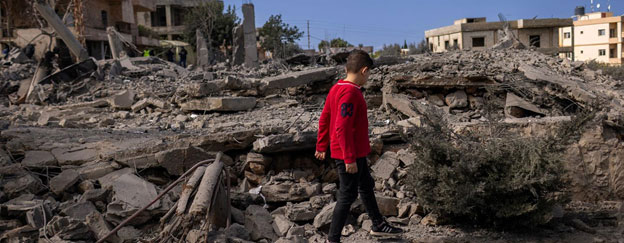UNITED NATIONS, Feb 25 (IPS) – In 2025, the world is facing a new and intensifying era of crisis for children. Climate change, economic instability, and conflict are hitting harder and more often, intersecting in ways that make the challenges of addressing them even more severe.
A five-year-old walks amongst the ruins of houses in southern Lebanon. An increasingly turbulent geopolitical and financial landscape mean systems for protecting children must be stronger than ever.
These developments reflect a world of rising geopolitical tensions and competition among nations that is delaying global action we desperately need.
For children, the stakes couldn’t be higher. To uphold children’s rights and well-being, we need to rethink how to strengthen the very systems that provide key services for children. These systems must be equipped to meet immediate needs, withstand growing pressures, and adapt to the uncertainties of the future.
Resilience has to be built into every part of these systems, ensuring they can protect children at scale, no matter the crisis.
When it comes to geopolitics, conflicts and war will continue to be among the most serious threat to children’s lives and wellbeing. Over 473 million children – more than one in six globally – now live in areas affected by conflict, with the world experiencing the highest number of conflicts since World War II.
In these settings, systems for protecting children must be stronger than ever. Clear rules of engagement for military forces, measures to address violations by non-state actors, and effective monitoring and reporting systems are all crucial to safeguarding children’s lives and rights in conflict zones.
Squeezed from all sides
The economic landscape is no less alarming. Right now, governments’ coffers are being hit by a mix of weak tax revenues, declining aid and rising debt. Rising debt, in particular, is creating unprecedented budget pressures. Nearly 400 million children live in countries facing debt distress, where the financial squeeze is cutting into investments in education, healthcare, and safety nets.
In 2025, we face crucial decisions about reforms to the framework of institutions, policies, rules and practices that govern the global financial system – decisions that could reshape the financial landscape to prioritize sustainable development, intergenerational equity and investment in children.
Climate change, of course, is a crisis that touches every aspect of children’s lives. From extreme weather destroying schools to diseases spreading in its wake, children are disproportionately affected.
In 2025, we must focus on ensuring that climate governance and accountability mechanisms work for children – from incorporation of child rights into national mitigation and adaptation policies to providing necessary finance to implement these plans. Strengthening legally backed climate reporting and monitoring are key to effective climate action for children.
Securing the digital future
When it comes to technological trends, we see clear benefits but also potential risks for children – a reality of the past several years that will continue in 2025. Rapid adoption of digital public infrastructure is one of the trends that can enable systemic changes and fundamentally shift how governments engage with citizens.
But what is digital public infrastructure (DPI)? Sometimes compared to physical infrastructure, digital infrastructure can allow citizens to access digital public services and take part in digital economy through use of digital IDs, data sharing and digital payment systems.
DPI can play a crucial role in advancing children’s well-being by ensuring equitable access to essential services such as education, health care and social protection.
However, DPI it is not inherently inclusive, and too often children in lower income settings are left behind. So, we must prioritize children’s rights and enable seamless, safe and secure data exchange between health, education, and social services to create a holistic support system for child development.
In 2025 and beyond, progress for children demands stronger alignment between global and national priorities. Strengthening national systems and ensuring they are aligned vertically (from global to local) and nationally (across sectors) is critical to achieving our shared goals in health, education, safety, poverty eradication and climate adaptation.
Getting it right creates a foundation of resilience. After all, children and young people are looking to us to ensure their futures today.
Jasmina Byrne is Chief, Foresight & Policy, UNICEF Innocenti – Global Office of Research and Foresight.




